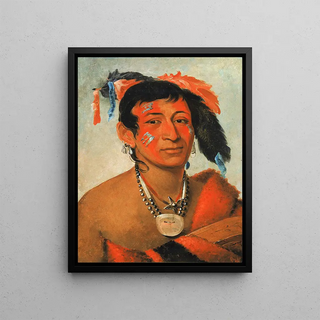Art print | Sha-W-No The South, a renowned warrior - George Catlin


View from behind

Frame (optional)
In the vast panorama of art history, some works transcend their era to become timeless witnesses of culture and identity. The art print Sha-W-No Le Sud, un guerrier reconnu - George Catlin, belongs to this tradition. This painting, which captures the very essence of a Native American chief, invites viewers to immerse themselves in a world where nature and humanity coexist in harmony. Through Sha-W-No’s piercing gaze, Catlin offers a poignant vision of indigenous peoples’ lives, while also prompting reflection on collective memory and the preservation of traditions. This piece, far more than a simple representation, is an open door to a rich and complex narrative.
Style and uniqueness of the work
George Catlin’s style is undeniably characterized by a realistic approach and meticulous attention to detail. In the art print Sha-W-No Le Sud, un guerrier reconnu, each brushstroke seems to vibrate with palpable energy, paying tribute to the dignity and strength of the subject. The colors, both vivid and nuanced, illustrate not only the physical appearance of the warrior but also his soul and spirit. Catlin does not merely paint a man; he immortalizes a symbol of resistance and cultural pride. The warrior’s posture, his determined gaze, and the decorative elements surrounding him, such as feathers and traditional motifs, reinforce this impression of grandeur. The work is thus a celebration of Native American identity, while subtly critiquing the colonial forces that threatened to erase these cultures.
The artist and his influence
George Catlin, 19th-century painter and adventurer, dedicated his life to documenting the lifestyles of Native American tribes, becoming one of the first artists to make the representation of indigenous peoples a central subject of his work. His influence extends far beyond his time, inspiring many contemporary artists and researchers to explore themes of identity, memory, and representation. Catlin was able to capture the essence of his subjects with rare sensitivity, giving voice to those often silenced.

Matte finish

View from behind

Frame (optional)
In the vast panorama of art history, some works transcend their era to become timeless witnesses of culture and identity. The art print Sha-W-No Le Sud, un guerrier reconnu - George Catlin, belongs to this tradition. This painting, which captures the very essence of a Native American chief, invites viewers to immerse themselves in a world where nature and humanity coexist in harmony. Through Sha-W-No’s piercing gaze, Catlin offers a poignant vision of indigenous peoples’ lives, while also prompting reflection on collective memory and the preservation of traditions. This piece, far more than a simple representation, is an open door to a rich and complex narrative.
Style and uniqueness of the work
George Catlin’s style is undeniably characterized by a realistic approach and meticulous attention to detail. In the art print Sha-W-No Le Sud, un guerrier reconnu, each brushstroke seems to vibrate with palpable energy, paying tribute to the dignity and strength of the subject. The colors, both vivid and nuanced, illustrate not only the physical appearance of the warrior but also his soul and spirit. Catlin does not merely paint a man; he immortalizes a symbol of resistance and cultural pride. The warrior’s posture, his determined gaze, and the decorative elements surrounding him, such as feathers and traditional motifs, reinforce this impression of grandeur. The work is thus a celebration of Native American identity, while subtly critiquing the colonial forces that threatened to erase these cultures.
The artist and his influence
George Catlin, 19th-century painter and adventurer, dedicated his life to documenting the lifestyles of Native American tribes, becoming one of the first artists to make the representation of indigenous peoples a central subject of his work. His influence extends far beyond his time, inspiring many contemporary artists and researchers to explore themes of identity, memory, and representation. Catlin was able to capture the essence of his subjects with rare sensitivity, giving voice to those often silenced.






